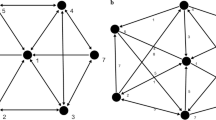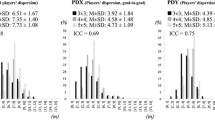Abstract
Significant criticisms have emerged on the way that collective behaviours in team sports have been traditionally evaluated. A major recommendation has been for future research and practice to focus on the interpersonal relationships developed between team players during performance. Most research has typically investigated team game performance in subunits (attack or defence), rather than considering the interactions of performers within the whole team. In this paper, we offer the view that team performance analysis could benefit from the adoption of biological models used to explain how repeated interactions between grouping individuals scale to emergent social collective behaviours. We highlight the advantages of conceptualizing sports teams as functional integrated ‘super-organisms’ and discuss innovative measurement tools, which might be used to capture the superorganismic properties of sports teams. These tools are suitable for revealing the idiosyncratic collective behaviours underlying the cooperative and competitive tendencies of different sports teams, particularly their coordination of labour and the most frequent channels of communication and patterns of interaction between team players. The principles and tools presented here can serve as the basis for novel approaches and applications of performance analysis devoted to understanding sports teams as cohesive, functioning, high-order organisms exhibiting their own peculiar behavioural patterns.




Similar content being viewed by others
References
Kerr NL, Tindale RS. Group performance and decision making. Annu Rev Psychol 2004; 55: 623–55
Hughes M, Bartlett R. The use of performance indicators in performance analysis. J Sports Sci 2002; 20: 739–54
Hughes M. Notational analysis: a mathematical perspective. Int J Perf Anal Sport 2004; 4: 97–139
Lago C, Martin R. Determinants of possession of the ball in soccer. J Sports Sci 2007; 25: 969–74
Tenga A, Holme I, Ronglan LT, et al. Effect of playing tactics on achieving score-box possessions in a random series of team possessions from Norwegian professional soccer matches. J Sports Sci 2010; 28: 245–55
James N. Notational analysis in soccer: past, present and future. Int J Perf Anal Sport 2006; 6: 67–81
Lames M, Ertmer J, Walter F. Oscillations in football: order and disorder in spatial interactions between the two teams. Int J Sport Psychol 2010; 41: 85–6
Yue Z, Broich H, Seifriz F, et al. Mathematical analysis of a soccer game. Part I: individual and collective behaviors. Stud Appl Math 2008; 121: 223–43
Bourbousson G, Sève C, McGarry T. Space-time coordination dynamics in basketball: part 2. The interaction between the two teams. J Sports Sci 2010; 28: 349–58
Sumpter DJT. The principles of collective animal behaviour. Phil Trans R Soc B 2006; 361: 5–22
Couzin ID. Collective cognition in animal groups. Trends Cogn Sci 2009; 13: 36–43
Grehaigne JF, Bouthier D, David B. Dynamic-system analysis of opponent relationships in collective actions in soccer. J Sports Sci 1997; 15: 137–49
Marsh KL, Richardson MJ, Baron RM, et al. Contrasting approaches to perceiving and acting with others. Ecol Psychol 2006; 18: 1–38
Marsh KL, Richardson MJ, Schmidt RC. Social connection through joint action and interpersonal coordination. Top Cogn Sci 2009; 1: 320–39
Krause J, Ruxton GD, Krause S. Swarm intelligence in animals and humans. Trends Ecol Evol 2010; 25: 28–34
Passos P, Milho J, Fonseca S, et al. Interpersonal distance regulates functional grouping tendencies of agents in team sports. J Motor Behav 2011; 43: 155–63
Correia V, Araújo D, Davids K, et al. Territorial gain dynamics regulates success in attacking sub-phases of team sports. Psychol Sport Exerc 2011; 12: 662–9
Wilson DS, Wilson EO. Rethinking the theoretical foundation of sociobiology. Q Rev Biol 2007; 82: 327–48
Gardner A, Grafen A. Capturing the superorganism: a formal theory of group adaptation. J Evol Biol 2009; 22: 659–71
Edelman GM, Gally JA. Degeneracy and complexity in biological systems. Proc Natl Acad Sci U S A 2001; 98: 13763–8
Seeley TD. The honey bee colony as a superorganism. Amer Sci 1989; 77: 546–53
Seeley TD. Decision making in superorganisms: how collective wisdom arises from the poorly informed masses. In: Gigerenzer G, Selten R, editors. Bounded rationality: the adaptive toolbox. Cambridge: MIT Press, 2001: 249–61
Wilson DS, Sober E. Reviving the superorganism. J Theor Biol 1989; 136: 337–56
Wheeler WM. The ant-colony as an organism. J Morphol 1911; 22: 307–25
Crozier RH. Insect sociobiology: the genetics of social evolution. Science 1989; 245: 313–4
Reeve HK, Hölldobler B. The emergence of a super-organism through intergroup competition. Proc Natl Acad Sci U S A 2007; 104: 9736–40
Mlot NJ, Tovey CA, Hu DL. Fire ants self-assemble into waterproof rafts to survive floods. Proc Natl Acad Sci U S A 2011; 108:7669–73
Hölldobler B, Wilson EO. The superorganism: the beauty, elegance, and strangeness of insect societies. London: W.W. Norton, 2009
Eccles D. The coordination of labour in sports teams. Int Rev Sport Exerc Psychol 2010; 3: 154–70
Duch J, Waitzman JS, Amaral LAN. Quantifying the performance of individual players in a team activity. PLoS ONE 2010; 5: e10937
Passos P, Davids K, Araújo D, et al. Networks as a novel tool for studying team ball sports as complex social systems. J Sci Med Sport 2011; 14: 170–6
Araújo D, Davids K, Hristovski R. The ecological dynamics of decision making in sport. Psychol Sport Exerc 2006; 7: 653–76
Gibson JJ. The ecological approach to visual perception. Boston: Houghton Mifflin, 1979
Fajen B, Riley MR, Turvey MT. Information, affordances and control of action in sports. Int J Sport Psychol 2009; 40: 79–107
Dicks M, Davids K, Button C. Individual differences in the visual control of intercepting a penalty kick in association football. Hum Mov Sci 2010; 29: 401–11
Duarte R, Frias T. Collective intelligence: An incursion into the tactical performance of football teams. In: Jemni M, Bianco A, Palma A, editors. Proceedings of the First International Conference in Science and Football; 2011 Apr 15–17; Palermo: 23–28
Travassos B, Araújo D, Vilar L, et al. Interpersonal coordination and ball dynamics in futsal (indoor football). Hum Mov Sci 2011; 30: 1245–59
Watts DJ, Strogatz SH. Collective dynamics of ‘small-world’ networks. Nature 1998; 393: 440–2
Frencken W, Lemmink K, Delleman NJ, et al. Oscillations of centroid position and surface area of soccer teams in small-sided games. Eur J Sport Sci 2011; 4: 215–23
Duarte R, Araújo D, Davids K, et al. In search for dynamical patterns of teams’ tactical behaviours during the match 2011 [abstract no. 114 plus oral presentation]. VIIth World Congress on Science & Football; 2011 May 26–30; Nagoya
McGarry T. Applied and theoretical perspectives of performance analysis in sport: scientific issues and challenges. Int J Perf Anal Sport 2009; 9: 128–40
Frank TD, Richardson MJ. On a test statistic for the Kuramoto order parameter of synchronization: an illustration for group synchronization during rocking chairs. Physica D 2010; 239: 2084–92
Kuramoto Y, Nishikawa I. Statistical macrodynamics of large dynamical systems: case of a phase transition in oscillator communities. J Stat Phys 1987; 49: 569–605
Neda Z, Ravasz E, Brechet Y, et al. The sound of many hands clapping. Nature 2000; 403: 849–50
Taki T, Hasegawa J. Quantitative measurement of teamwork in ball games using dominant region. ISPRS J Photogramm 2000; 33: 125–31
Taki T, Hasegawa J. Dominant region: a basic feature for group motion analysis and its application to teamwork evaluation in soccer games. P SPIE IS&T Elect IM 1998; 3641:48–57
Taki T, Hasegawa J. Visualization of dominant region in team games and its application to teamwork analysis. In: Proceedings of the International Conference on Computer Graphics; 2000 Jun 19–24; Geneva, 227–235
Deneubourg JL. Application de l’ordre par fluctuations à la description de certaines étapes de la construction du nid chez les termites. Insect Soc 1977; 24: 117–30
Couzin ID, Krause J, James R, et al. Collective memory and spatial sorting in animal groups. J Theor Biol 2002; 218: 1–11
Glazier P. Game, set and match? Substantive issues and future directions in performance analysis. Sports Med 2010; 40: 625–34
Vilar L, Araújo D, Davids K, et al. The role of ecological dynamics in analysing performance in team sports. Sports Med 2012; 42: 1–10
Barris S, Button C. A review of vision-based motion analysis in sport. Sports Med 2008; 38: 1025–43
Carling C, Bloomfield J, Nelson L, et al. The role of motion analysis in elite soccer: contemporary performance measurement techniques and work rate data. Sports Med 2008; 38: 389–862
Correia V, Araújo D, Duarte R, et al. Changes in practice task constraints shape decision-making behaviours of team games players. J Sci Med Sport 2012; 15 (3): 244–9
Acknowledgements
This research was partially supported by a grant (SFRH/BD/43994/2008) awarded to Ricardo Duarte by the Foundation for Science and Technology (Portugal). The authors wish to thank Hugo Foldado, Telmo Frias and Tsuyoshi Taki for their valuable help in some computation procedures. The authors have no conflicts of interest to declare that are directly relevant to the content of this review.
Author information
Authors and Affiliations
Corresponding author
Rights and permissions
About this article
Cite this article
Duarte, R., Araújo, D., Correia, V. et al. Sports Teams as Superorganisms. Sports Med 42, 633–642 (2012). https://doi.org/10.1007/BF03262285
Published:
Issue Date:
DOI: https://doi.org/10.1007/BF03262285




